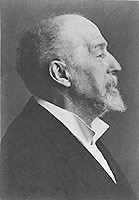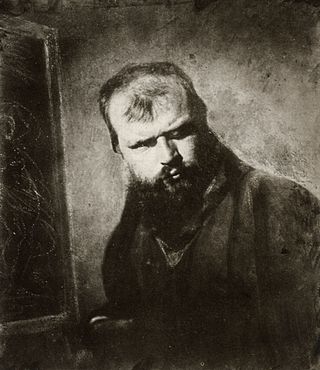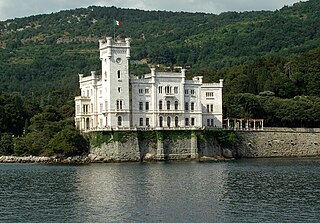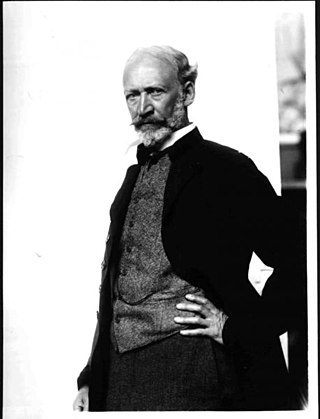Life and work
His father, Andreas Luntz, was a local official. In 1847, the family moved to Vienna where, from 1856 to 1860, he studied at the Polytechnic Institute then, from 1860 to 1864, at the Academy of Fine Arts. He was awarded the academy's Gundel-Prize for excellence in 1862. His primary instructors there were August Sicard von Sicardsburg and Eduard van der Nüll. Later, he worked with Friedrich von Schmidt, who was building the new Vienna City Hall. He also completed an apprenticeship as a stonemason.
In 1874, he married Auguste Felicitas Wielemans, sister of the architect, Alexander Wielemans [ de ], in whose studio he was working. In 1885 the College of Technology (the former Polytechnic Institute) named him to fill the chair of Medieval and Christian architecture, left vacant by the death of Heinrich von Ferstel, two years previously. From 1892 until his death, he was the head Professor of the special school for Medieval architecture at the academy. His notable students included Hubert Gangl [ de ], Rudolf Wiskoczil and Max Hegele, who designed the church at the Wiener Zentralfriedhof.
His wife died in 1885, leaving him with five sons. His eldest, Adolf [ de ], became a well known landscape painter.
Few of his works were especially prominent; the notable exception being the St. Francis of Assisi Church, one of several church buildings he designed. He also did restorative work and expansions at the Maria am Gestade church and the Minoritenkirche.
He had a stroke while attending a meeting at the academy, and died shortly after, at the age of sixty-three. In 1920, a street in Vienna's Brigittenau district was named after him.

Otto Koloman Wagner was an Austrian architect, furniture designer and urban planner. He was a leading member of the Vienna Secession movement of architecture, founded in 1897, and the broader Art Nouveau movement. Many of his works are found in his native city of Vienna, and illustrate the rapid evolution of architecture during the period. His early works were inspired by classical architecture. By mid-1890s, he had already designed several buildings in what became known as the Vienna Secession style. Beginning in 1898, with his designs of Vienna Metro stations, his style became floral and Art Nouveau, with decoration by Koloman Moser. His later works, 1906 until his death in 1918, had geometric forms and minimal ornament, clearly expressing their function. They are considered predecessors to modern architecture.

TU Wien, also known as the Vienna University of Technology, is a public research university in Vienna, Austria.

Baron Theophil Edvard von Hansen was a Danish architect who later became an Austrian citizen. He became particularly well known for his buildings and structures in Athens and Vienna, and is considered an outstanding representative of Neoclassicism and Historicism.

Peter Johann Nepomuk Geiger was a Viennese artist.

Ludwig Thiersch was a German painter, primarily of mythological and religious subjects and especially of ecclesiastical art, also influential in Greece.

Carl Rahl, sometimes spelled Karl Rahl, was an Austrian painter.

Freiherr Heinrich von Ferstel was an Austrian architect and professor, who played a vital role in building late 19th-century Vienna.

Carl Gangolf Kayser was an Austrian architect at the service of Emperor Maximilian I of Mexico, during the Second Mexican Empire. In the later part of his life he returned to Austria and worked on restoring medieval castles.

Eduard van der Nüll was an Austrian architect, who was one of the great masters in the historicist style of Vienna's Ringstrasse.

Frigyes Schulek was a Hungarian architect, a professor at József Technical University and a member of the Hungarian Academy of Sciences (Magyar Tudományos Akadémia).

Carl Junker was an Austrian engineer and architect. His construction projects include Miramare Castle in Trieste and the First Vienna Mountain Spring Pipeline.

Julius Mayreder was an Austrian architect.
Gustav Adolf Franz Xavier Gugitz was an Austrian architect.

Georg Decker was an Austro-Hungarian portrait artist.

August Schwendenwein von Lanauberg was an Austrian architect who built several Viennese palaces.

Wunibald Deininger was an Austrian architect and art teacher.

Hans Bitterlich was an Austrian sculptor.

Josef Ondřej Kranner, or Joseph Andreas Kranner was a Czech architect. He became the first Master Builder at St. Vitus Cathedral when construction resumed there in 1861.

Josef Schulz was a Czech architect, designer, teacher and restorer.

Friedrich Ohmann was an Austrian architect in the Historicist style.
This page is based on this
Wikipedia article Text is available under the
CC BY-SA 4.0 license; additional terms may apply.
Images, videos and audio are available under their respective licenses.




















